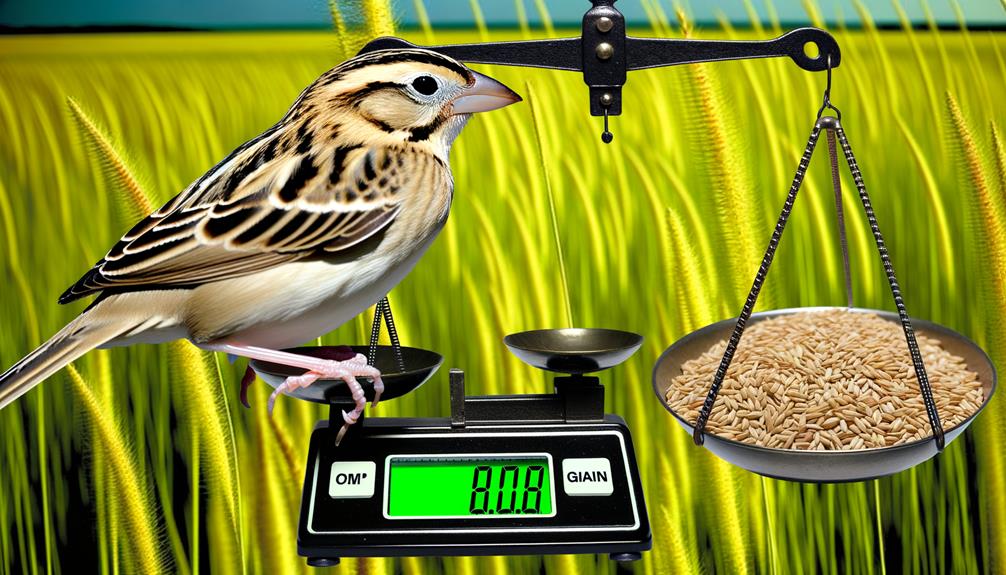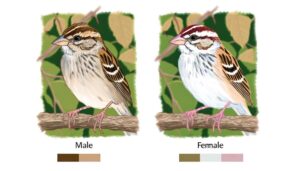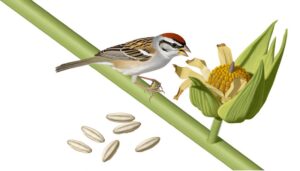How Much Does a Florida Grasshopper Sparrow’s Weight Measure?
The Florida Grasshopper Sparrow, native to Florida's prairies and grasslands, typically weighs between 17 to 19 grams. This weight can vary slightly due to factors such as age, gender, and diet.
These sparrows' weight impacts crucial aspects of their lives such as flight agility, feeding efficiency, and mating success. An ideal balance between weight and flight agility is crucial for their survival.
For a deeper understanding of how weight affects the intricate lifestyle of this ground-dwelling bird species, one might want to explore further.

Key Takeaways
- The Florida Grasshopper Sparrow typically weighs between 17-19 grams.
- If the bird weighs less than 17 grams, it is considered underweight.
- If the sparrow weighs more than 20 grams, it is considered overweight.
- Factors like diet, habitat conditions, age, and gender influence the sparrow's weight.
- Maintaining an ideal weight range of 17-20 grams is crucial for the sparrow's successful mating and survival.
Understanding the Grasshopper Sparrow
Exploring the domain of the Grasshopper Sparrow, it's notable that this small, elusive bird species is exclusive to Florida's prairies and grasslands. Their habitats are very specific, requiring dry, well-drained areas with low vegetation for nesting and feeding. These sparrows are ground-dwelling, making them particularly vulnerable to habitat loss and predation.
They're recognized for their insect-like song, hence the name 'Grasshopper Sparrow.' They primarily feed on insects and seeds, using their sharp beaks and agile bodies to forage efficiently. They're solitary birds, except during breeding season. Despite their size, they're resilient, enduring the harsh conditions of their habitats.
Understanding the Grasshopper Sparrow's lifestyle and preferences is essential in approaching the question of their weight.
Physical Characteristics
The Florida Grasshopper Sparrow, a small bird of notable significance, possesses distinct physical characteristics that contribute to its unique identity.
Critical to understanding this avian species are two interrelated aspects: the body size of the sparrow and the coloration patterns of its feathers.
These elements not only aid in the bird's identification, but also provide key insights into its behavior, habitat preferences, and overall physiology.
Sparrow's Body Size
Characterized by its compact size, a typical Florida Grasshopper Sparrow weighs approximately 17-19 grams, demonstrating one of the tiniest profiles in the sparrow species. This weight is incredibly light in comparison to other birds, even within the sparrow family.
The bird's length usually ranges from 12-13 centimeters, contributing to its distinctive petite stature. Its wingspan, though proportionate to its size, is relatively small as well, typically extending to about 18-21 centimeters. This small wingspan enables quick, agile flight, essential for its survival in the wild.
The bird's size varies slightly between males and females, with females generally being slightly smaller. The compact, lightweight physique of the Florida Grasshopper Sparrow aids in its adaptability and survival in the diverse environments of Florida.
Feather Coloration Patterns
Adorning this miniature avian marvel, the Florida Grasshopper Sparrow's feathers display a distinct palette of earthy tones, contributing greatly to its camouflage abilities in its grassland habitat. The bird's plumage isn't flamboyant; rather, it's designed for survival.
Three key elements characterize its coloration pattern:
- Upperparts: A mixture of browns and grays, providing perfect concealment in grassy environments.
- Underparts: Lighter shades, primarily whites and soft grays, allowing the bird to blend with the sky when seen from below.
- Head markings: Dark stripes on a lighter background, breaking up the bird's silhouette and making it harder for predators to spot.
Such intricate feather coloration patterns demonstrate nature's attention to detail, ensuring the sparrow's survival in its native Florida grasslands.
Weighing a Florida Grasshopper Sparrow
Despite their diminutive size, accurately weighing a Florida Grasshopper Sparrow can offer critical insights into their overall health and fitness. This process, however, isn't as straightforward as it may seem. It involves the use of specialized equipment, like a high-precision digital scale, capable of measuring to the nearest milligram.
Scientists delicately handle the bird, ensuring minimal stress. They place it in a small, soft bag that's then set on the scale. The weight is recorded and compared to a healthy range.
| Healthy Weight Range (g) | Indications |
|---|---|
| 17-20 | Peak Health |
| < 17 | Underweight |
| > 20 | Overweight |
These values serve as a health baseline. It's important to remember that individual variations exist, which the next subtopic will discuss.
Factors Influencing Sparrow Weight
Numerous variables can impact the weight of a Florida Grasshopper Sparrow, ranging from its diet and habitat conditions to factors like age and gender.
- Diet: Sparrows consuming a diet rich in insects and seeds can maintain a healthier weight, as these are their primary sources of energy and nutrients.
- Habitat Conditions: The quality of a sparrow's habitat can directly affect its weight. Sparrows in nutrient-rich environments typically weigh more than those in nutrient-poor habitats.
- Age and Gender: Older sparrows can be heavier due to developed muscle mass. Additionally, males are usually heavier than females due to their larger size.
These elements can greatly influence the weight of a Florida Grasshopper Sparrow. Understanding them is essential for effective conservation efforts.
Comparing Sparrow Weights
When comparing the weights of different Florida Grasshopper Sparrows, it's important to take into account variables such as diet, habitat conditions, age, and gender, as these factors play a significant role in the weight variations observed among these birds.
Male sparrows, for instance, typically weigh more than their female counterparts. Moreover, adult sparrows tend to be heavier than younger ones, largely due to their fully developed muscles and bones.
Diet is another critical factor, as sparrows feeding on nutrient-rich insects and seeds gain weight faster than those with a less nutritious diet.
Impact of Weight on Sparrow's Lifestyle
The weight of the Florida Grasshopper Sparrow greatly impacts its daily activities. A lighter weight allows for more agile and prolonged flight, while a heavier weight may restrict these abilities but could enhance feeding efficiency.
Additionally, the sparrow's weight may influence its mating success. Potential mates could associate greater weight with better health and survival capacity.
Sparrow Weight and Flight
In the life of a Florida Grasshopper Sparrow, weight plays an important role in its ability to take flight and navigate its environment efficiently. The bird's weight is a balancing act between energy conservation and flight performance.
Energy Conservation: A lighter sparrow uses less energy in flight, increasing survival rates when food is scarce.
Flight Performance: However, a too light sparrow may struggle against wind and weather, reducing its ability to find food and evade predators.
Environmental Navigation: Best weight also affects the bird's agility in flight, impacting its ability to hunt and avoid danger.
Therefore, maintaining an ideal weight is pivotal for the Florida Grasshopper Sparrow's survival. This delicate balance is a tribute to nature's fine-tuned design.
Feeding Habits and Weight
Balancing their daily dietary intake, Florida Grasshopper Sparrows meticulously monitor their weight to maintain peak flight conditions and survival. They primarily consume insects, and the nutritional content of their diet directly influences their weight.
Higher protein intake, obtained from their insectivorous diet, contributes to muscle development, thereby increasing their body mass. However, a heavier weight can also restrict their flight agility, an essential aspect for escaping predators. Therefore, they must strike a careful balance.
Seasonal variation in food availability also impacts their weight. During winter, lower insect population might lead to weight loss, while the abundance of food in spring could result in weight gain. Understanding this intricate relationship between feeding habits and weight is key to protecting this endangered species.
Weight Influencing Mating Success
Carrying a perfect weight, Florida Grasshopper Sparrows have an increased chance of attracting mates, showcasing the significant impact of body mass on their reproductive success.
Observations from the field have led to three key insights:
- Sparrows within an ideal weight range are more likely to mate successfully.
- Underweight sparrows can't compete effectively for mates, potentially due to lower energy levels and physical robustness.
- Overweight sparrows may also struggle, possibly due to decreased mobility and increased vulnerability to predators.
These findings underscore the delicate balance that these birds must maintain. Too little weight can lead to weakness and competitive disadvantage, while too much can hinder agility and attract predators.
It's a finely tuned system, showing nature's meticulous calibration.
Conclusion
To sum up, the diminutive Florida Grasshopper Sparrow typically weighs between 17.5 to 28 grams.
It's fascinating that such a small creature, weighing less than a handful of paper clips, can have an enormous impact on its ecosystem.
This statistic underscores the importance of preserving the Sparrow's habitat and ensuring its survival.
Every gram counts when it comes to the Sparrow's ability to thrive and contribute to Florida's biodiversity.






